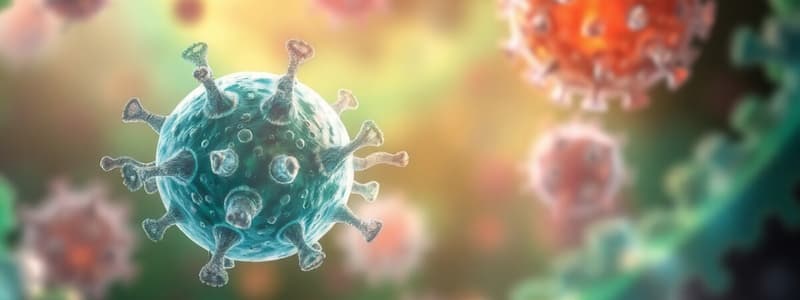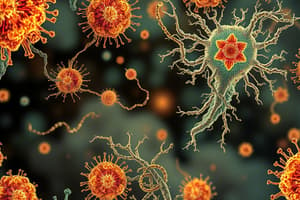Podcast
Questions and Answers
What percentage of known microorganisms are known to cause disease?
What percentage of known microorganisms are known to cause disease?
- 10%
- 25%
- 1% (correct)
- 50%
Which of the following groups is NOT classified as a microorganism?
Which of the following groups is NOT classified as a microorganism?
- Plants (correct)
- Bacteria
- Viruses
- Fungi
In what environments can microorganisms be found?
In what environments can microorganisms be found?
- Exclusively in water bodies
- Only in soil and deserts
- In human body and various extreme environments (correct)
- Only in natural habitats like forests
Which of the following is NOT a practical application of microorganisms?
Which of the following is NOT a practical application of microorganisms?
What is the relationship between microorganisms and higher organisms?
What is the relationship between microorganisms and higher organisms?
How long have microorganisms been part of Earth's biosphere?
How long have microorganisms been part of Earth's biosphere?
What role do microorganisms play in the production of pharmaceuticals?
What role do microorganisms play in the production of pharmaceuticals?
Which statement about microorganisms is accurate?
Which statement about microorganisms is accurate?
What is the role of microorganisms in the fermentation of bread dough?
What is the role of microorganisms in the fermentation of bread dough?
Which microorganism is specifically mentioned as being used to produce bio-butanol?
Which microorganism is specifically mentioned as being used to produce bio-butanol?
What theory regarding disease was invented and later discarded, leading to the acceptance of the microbe theory?
What theory regarding disease was invented and later discarded, leading to the acceptance of the microbe theory?
Which group of Archaea is responsible for producing methane through anaerobic metabolism?
Which group of Archaea is responsible for producing methane through anaerobic metabolism?
What essential role do microorganisms play in the human colon?
What essential role do microorganisms play in the human colon?
Who is credited with the scientific understanding that microorganisms exist in nature but cannot be seen?
Who is credited with the scientific understanding that microorganisms exist in nature but cannot be seen?
Which of the following is NOT a benefit of microorganisms in environmental applications?
Which of the following is NOT a benefit of microorganisms in environmental applications?
Which process involves the use of microorganisms to break down organic matter in sewage?
Which process involves the use of microorganisms to break down organic matter in sewage?
In historical microbiology, what practice unintentionally utilized microorganisms for preservation?
In historical microbiology, what practice unintentionally utilized microorganisms for preservation?
What field relies heavily on microorganisms to engineer new biological systems?
What field relies heavily on microorganisms to engineer new biological systems?
What notable feature of Pasteur's swan-necked flask experiment helped prevent contamination?
What notable feature of Pasteur's swan-necked flask experiment helped prevent contamination?
Which disease was NOT mentioned as a factor Pasteur worked with?
Which disease was NOT mentioned as a factor Pasteur worked with?
What was the year of the discovery of the rabies vaccine by Louis Pasteur?
What was the year of the discovery of the rabies vaccine by Louis Pasteur?
Which individual significantly supported Pasteur in establishing the Pasteur Institute?
Which individual significantly supported Pasteur in establishing the Pasteur Institute?
What form of recognition did Sultan II. Abdulhamid provide to Pasteur for his work?
What form of recognition did Sultan II. Abdulhamid provide to Pasteur for his work?
What was the main objective of Pasteur's letter to heads of state after the rabies vaccine discovery?
What was the main objective of Pasteur's letter to heads of state after the rabies vaccine discovery?
Which characteristic is most associated with the discipline founded by Pasteur's suggestion that microorganisms cause disease?
Which characteristic is most associated with the discipline founded by Pasteur's suggestion that microorganisms cause disease?
What theory did Turberville Needham defend regarding the origin of life?
What theory did Turberville Needham defend regarding the origin of life?
What did Antonie Lavoisier claim was necessary for life?
What did Antonie Lavoisier claim was necessary for life?
What was Lazzaro Spallanzani's primary assertion against spontaneous generation?
What was Lazzaro Spallanzani's primary assertion against spontaneous generation?
What technique is John Tyndall known for developing?
What technique is John Tyndall known for developing?
Which scientist is considered one of the founders of modern microbiology?
Which scientist is considered one of the founders of modern microbiology?
Why were Spallanzani's findings initially rejected?
Why were Spallanzani's findings initially rejected?
What was the primary mistake in Needham's experiments?
What was the primary mistake in Needham's experiments?
What did Pasteur demonstrate about fermentation?
What did Pasteur demonstrate about fermentation?
In Tyndall's experiments, what temperature range was used for sterilization during the Tyndalization method?
In Tyndall's experiments, what temperature range was used for sterilization during the Tyndalization method?
What did George Schröder and Theodor von Dusch conclude from their air-filtering experiments?
What did George Schröder and Theodor von Dusch conclude from their air-filtering experiments?
Who is known as the father of microbiology?
Who is known as the father of microbiology?
What term did Antonie van Leeuwenhoek use to refer to the microorganisms he observed?
What term did Antonie van Leeuwenhoek use to refer to the microorganisms he observed?
In which year did Robert Hooke publish his first observations of microorganisms?
In which year did Robert Hooke publish his first observations of microorganisms?
What was the primary scientific instrument used by Antonie van Leeuwenhoek to observe microorganisms?
What was the primary scientific instrument used by Antonie van Leeuwenhoek to observe microorganisms?
Which misconception is commonly held about the discovery of microorganisms?
Which misconception is commonly held about the discovery of microorganisms?
What did Akşemseddin emphasize about the transmission of diseases?
What did Akşemseddin emphasize about the transmission of diseases?
What was a significant limitation of early observations made prior to Leeuwenhoek's advancements?
What was a significant limitation of early observations made prior to Leeuwenhoek's advancements?
How did Robert Hooke contribute to the field of microbiology?
How did Robert Hooke contribute to the field of microbiology?
What was the nature of the microorganisms observed by Antonie van Leeuwenhoek?
What was the nature of the microorganisms observed by Antonie van Leeuwenhoek?
What advancement did Antonie van Leeuwenhoek make in the field of microscopy?
What advancement did Antonie van Leeuwenhoek make in the field of microscopy?
Flashcards
Microbiology
Microbiology
The study of microscopic organisms, including bacteria, archaea, fungi, algae, protozoa, and viruses.
Microorganisms
Microorganisms
Tiny living things that include bacteria, archaea, fungi, algae, protozoa, and viruses.
Microbial biomass
Microbial biomass
The total mass of living microorganisms on Earth.
Microorganism applications
Microorganism applications
Signup and view all the flashcards
Medical applications of microbes
Medical applications of microbes
Signup and view all the flashcards
Beneficial microbes
Beneficial microbes
Signup and view all the flashcards
Harmful microbes
Harmful microbes
Signup and view all the flashcards
Microbial prevalence
Microbial prevalence
Signup and view all the flashcards
Oil Pollution Breakdown
Oil Pollution Breakdown
Signup and view all the flashcards
Heavy Metal Breakdown
Heavy Metal Breakdown
Signup and view all the flashcards
Wastewater Treatment
Wastewater Treatment
Signup and view all the flashcards
Biofuel Production
Biofuel Production
Signup and view all the flashcards
Microbial Enzymes
Microbial Enzymes
Signup and view all the flashcards
Methane Production
Methane Production
Signup and view all the flashcards
Microbial Fermentation
Microbial Fermentation
Signup and view all the flashcards
Microbial Waste Treatment
Microbial Waste Treatment
Signup and view all the flashcards
Industrial Microbiology
Industrial Microbiology
Signup and view all the flashcards
Synthetic Biology
Synthetic Biology
Signup and view all the flashcards
Antonie van Leeuwenhoek
Antonie van Leeuwenhoek
Signup and view all the flashcards
Microorganisms
Microorganisms
Signup and view all the flashcards
Simple Microscope
Simple Microscope
Signup and view all the flashcards
Robert Hooke
Robert Hooke
Signup and view all the flashcards
Micrographia
Micrographia
Signup and view all the flashcards
Diseases Transmission (early view)
Diseases Transmission (early view)
Signup and view all the flashcards
1676
1676
Signup and view all the flashcards
1665
1665
Signup and view all the flashcards
Animalcules
Animalcules
Signup and view all the flashcards
Father of Microbiology
Father of Microbiology
Signup and view all the flashcards
Pasteur's Swan-necked Flask
Pasteur's Swan-necked Flask
Signup and view all the flashcards
Pasteur's Rabies Vaccine
Pasteur's Rabies Vaccine
Signup and view all the flashcards
Institute Pasteur
Institute Pasteur
Signup and view all the flashcards
Sultan Abdul Hamid II's Support
Sultan Abdul Hamid II's Support
Signup and view all the flashcards
Germ Theory of Disease
Germ Theory of Disease
Signup and view all the flashcards
Microbiology
Microbiology
Signup and view all the flashcards
10,000 Gold Coins
10,000 Gold Coins
Signup and view all the flashcards
Spontaneous generation
Spontaneous generation
Signup and view all the flashcards
Turberville Needham
Turberville Needham
Signup and view all the flashcards
Lazzaro Spallanzani
Lazzaro Spallanzani
Signup and view all the flashcards
Pasteur's disproof
Pasteur's disproof
Signup and view all the flashcards
Tyndall's method
Tyndall's method
Signup and view all the flashcards
Tyndalization
Tyndalization
Signup and view all the flashcards
Louis Pasteur
Louis Pasteur
Signup and view all the flashcards
Oxygen theory
Oxygen theory
Signup and view all the flashcards
Microbial culture tubes
Microbial culture tubes
Signup and view all the flashcards
Microorganism forms
Microorganism forms
Signup and view all the flashcards
Study Notes
Microbiology Course Overview
- Microbiology is the study of very small, unicellular living organisms (microorganisms)
- Microorganisms, also known as microbes, are essential for life on Earth
- They are found everywhere, from soil and water to the depths of the earth's crust to inside animals and humans
- Microorganisms play a crucial role in various industries and significantly impact human lives, both positively and negatively
Course Content
- Introduction to microbiology
- Classification of microorganisms
- Morphology of bacteria and viruses
- Bacterial reproduction, genetics, and metabolism
- Bacterial and viral infection agents
- Fungal and fungal infection agents
- Immunity, hypersensitivity, and immunodeficiency
- Vaccines and immune serums
- Microbiota
- Antimicrobial chemotherapy
- Sterilization and disinfection
- Microbial contamination in pharmaceutical products
- Sterile pharmaceutical products
Academic Calendar
- Fall semester begins September 30, 2024 and ends January 10, 2025
- Midterm exams are November 16-24, 2024
- General exams are January 13-24, 2025
- Make-up exams are February 3-7, 2025
- Attendance requirements: 70% for theoretical courses; 80% for lab
Resources
- Burton's Microbiology for the Health Sciences (Paul G. Engelkirk)
- Lippincott's Illustrated Reviews Microbiology (Richard A. Harvey)
- I Contain Multitudes: The Microbes Within Us and a Grander View of Life (Ed Yong)
- Twelve Diseases That Changed Our World (Irwin W. Sherman)
- The Mind-Gut Connection (Emeran Mayer, MD)
Microbiology Applications
- Medical: Microorganisms are essential for producing antibiotics, vaccines, and other pharmaceuticals
- Agriculture: Microorganisms enhance soil fertility and promote plant growth, especially nitrogen-fixing bacteria like Rhizobium.
- Food Industry: Microorganisms are used to produce fermented foods/beverages, such as yogurt and cheese, and contribute to food flavor/texture/shelf life.
- Environmental: Microorganisms are used in bioremediation to clean up contaminated environments like oil spills.
- Biotechnology: Microorganisms like Clostridium acetobutylicum produce biofuels. Microbial enzymes are used in various industries
Microbiology Today
- Microbes affect human life in many ways, both good and bad
- The majority of microorganisms are beneficial and necessary for human health and the function of the planet
- Infectious diseases are less lethal in developed vs developing countries due to advances in hygiene, public health, and vaccinations, along with better antibiotic use
- Antibiotic resistance is a major concern that needs to continue to be addressed
Studying That Suits You
Use AI to generate personalized quizzes and flashcards to suit your learning preferences.



